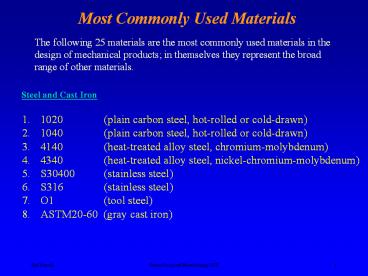Most Commonly Used Materials PowerPoint PPT Presentation
1 / 21
Title: Most Commonly Used Materials
1
Most Commonly Used Materials
The following 25 materials are the most commonly
used materials in the design of mechanical
products in themselves they represent the broad
range of other materials.
Steel and Cast Iron
- 1020 (plain carbon steel, hot-rolled or
cold-drawn) - 1040 (plain carbon steel, hot-rolled or
cold-drawn) - 4140 (heat-treated alloy steel,
chromium-molybdenum) - 4340 (heat-treated alloy steel,
nickel-chromium-molybdenum) - S30400 (stainless steel)
- S316 (stainless steel)
- O1 (tool steel)
- ASTM20-60 (gray cast iron)
2
Most Commonly Used Materials
3
Most Commonly Used Materials
Plastics
- ABS
- Polycarbonate
- Nylon 6/6
- Polypropylene
- Polystyrene
4
Application of Most Commonly Used Materials
Component
Material
5
Application of Most Commonly Used Materials
Component
Material
6
Application of Most Commonly Used Materials
Material
Component
7
Properties of Most Commonly Used Materials
Ultimate Strength in tension
8
Properties of Most Commonly used Materials
Yield strength
9
Properties of Most Commonly used Materials
Fatigue endurance limit (strength under cyclic
loading)
10
Properties of Most Commonly used Materials
Density
11
Cost of Most Commonly used Materials
12
Example Materials for table legs
Luigi Tavolino, furniture designer, conceives of
a lightweight table of daring simplicity a flat
sheet of toughened glass supported on slender,
unbraced, cylindrical legs. The legs must be
solid and as light as possible (to make the table
easier to move). They must support the table top
and whatever is placed upon it without buckling.
What materials could one recommend.
13
Example Materials for table legs
The Model
The leg is a slender column of density ? and
modulus E. The load P and its length l are
determined by design (fixed). The radius r of the
leg is a variable. We wish to minimize the mass m
of the leg.
14
Example Materials for table legs
The constraint is that the legs must support a
design load without buckling.
Eulers buckling equation
where I pr4/4
Solving for the free variable , r, and
substituting it into the equation for m gives,
15
Example Materials for table legs
Solving the Eulers formula for r, gives an
equation for the thinnest leg which will not
buckle
Material properties
16
Procedure for deriving material indices
17
Modulus of Elasticity (E) vs. Density (?) Charts
Constant guidelines
18
Modulus of Elasticity (E) vs. Density (?) Charts
19
Modulus of Elasticity (E) vs. Density (?) Charts
20
(No Transcript)
21
Summary of materials for table legs

